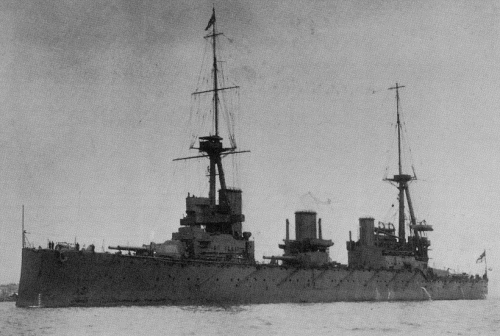
NAVYPEDIA
 Support the project with paypal
Support the project with paypal
Photo

Australia 1913
Ships
| Name | No | Yard No | Builder | Laid down | Launched | Comp | Fate |
|---|---|---|---|---|---|---|---|
| Australia | C6, 09, 81 | John Brown, Clydebank, UK | 23.6.1910 | 25.10.1911 | 6.1913 | stricken and scuttled 12.4.1924 |
Technical data
| Displacement normal, t | 18500 |
|---|---|
| Displacement full, t | 22110 |
| Length, m | 179.8 |
| Breadth, m | 24.4 |
| Draught, m | 8.10 mean |
| No of shafts | 4 |
| Machinery | 4 Parsons steam turbines, 32 Babcock & Wilcox boilers |
| Power, h. p. | 44000 |
| Max speed, kts | 25 |
| Fuel, t | coal 3170 + oil 840 |
| Endurance, nm(kts) | 6330(10) |
| Armour, mm | belt: 152 - 102, bulkheads: 178 - 152, turrets: 178 (all sides), 76 (roof), barbettes: 178 (over main deck) - 51 (under main deck), deck: 64 - 19, over magazines: 89, CT: 254 (face and sides) - 178 (rear) - 76 (roof) |
| Armament | 4 x 2 - 305/45 BL Mk X, 16 x 1 - 102/50 BL Mk VII, 4 x 1 - 47/40 3pdr Hotchkiss Mk I, 3 - 450 TT (2 beam, 1 stern) |
| Complement | 800 |
Graphics
Project history
The second ship of 1908 Programme was to be a battlecruiser equivalent of Neptune, but instead of taking the opportunity to remedy the weakness of Invincible they were virtually repeats of the design. The only excuse for building such a ship would be to speed up construction, but there was no justification for repeating the design when the Dominions of Australia and New Zealand voted money for their own capital ships. Australia was to become the flagship of new RAN, and New Zealand was presented to the RN on completion. As result new battlecruisers were repeats of Invincible lengthened to permit both 'P' and 'Q' turrets to fire on broadside, but unlike the original, displaced 1000t less than her battleship equivalent. Some attempt was made to improve armouring in Australia and New Zealand by deleting the thin armour at bow and stern and thickening the belt abreast of 'A' and 'X' turrets. Also machinery power was increased by 1000shp. During trials all three exceeded 26kts with boilers forcing.
The smoke nuisance was becoming evident by the time the ships were designed, and she received a tall fore funnel. In spite of the gap between the third funnel and the fire control position on the after tripod it still proved unuseable and during the war was dismantled.
Protection
152mm main belt with 3.36m height extended from barbette "A" to the barbette "Y" (127mm abreast barbettes "A" and "X"), closed at fore end by 102-76mm and by after end by 114 - 102mm bulkheads. Its full length was 144m (80% of hull length). Belt between barbette "A" and stem and between barbette "X" and stern had 19mm plating only. Main deck over citadel was 25mm with 25mm slopes (51mm over magazines), lower deck from barbette "Y" to barbette "A" covered by 38mm deck with 51mm slopes. Another part of lower deck was 51mm.
Modernizations
1914: - 4 x 1 - 47/40
3/1915: + 1 x 1 - 76/45 20cwt QF Mk I
1915: - 1 - 450 TT (stern)
11/1915: - 2 x 1 - 102/50
1916: + 25mm of armour thickness between "P" & "Q" barbettes and on the main deck in the wake of all barbettes.
6/1917: + 1 x 1 - 102/50 BL Mk VII (AA)
1918: + flying-off platforms (turrets "P" & "Q") for Sopwith Pup and 11.2-strutter.
1919: + 4 x 1 - 47/40 3pdr Hotchkiss Mk I
1/1920: - 1 x 1 - 102/50, 1 x 1 - 76/45; + 2 x 1 - 102/45 QF Mk V
Naval service
Australia collided with New Zealand on 22 April 1916 and both missed Jutland being under repair. Australia was ceremonially scuttled off Sydney Heads 12.4.1924.
 HOME
HOME FIGHTING SHIPS OF THE WORLD
FIGHTING SHIPS OF THE WORLD AUSTRALIA
AUSTRALIA CAPITAL SHIPS AND MONITORS
CAPITAL SHIPS AND MONITORS AUSTRALIA battlecruiser (1913)
AUSTRALIA battlecruiser (1913)
